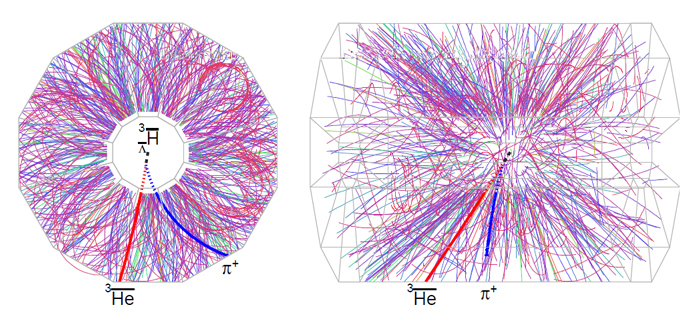The strangest form of antimatter ever seen has been discovered by the STAR experiment at the Relativistic Heavy Ion Collider (RHIC), at DOE’s Brookhaven National Laboratory in New York. The new particle goes by the jawbreaking name “anti-hyper-triton.”

A typical event in the STAR detector that includes the production and decay of an antihypertriton candidate (H3 with a bar indicates an antithydrogen 3 nucleus; the lambda with a bar indicates that it contains an antilambda). The dashed black line is the trajectory of the candidate, which cannot be directly measured. The heavy red and blue lines are the trajectories of an antihelium nucleus and a pion, decay daughters which are directly measured.
Translated, that means a nucleus of antihydrogen containing one antiproton and one antineutron – plus one heavy relative of the antineutron, an antilambda hyperon. It’s that massive antilambda that makes the newly discovered antinucleus “hyper.”
“STAR is the only experiment that could have found an antimatter hypernucleus,” says Nu Xu of Berkeley Lab’s Nuclear Science Division, the spokesperson for the STAR experiment. “We’ve been looking for them ever since RHIC began operations. The discovery opens the door on new dimensions of antimatter, which will help astrophysicists trace back the story of matter to the very first millionths of a second after the big bang.”
RHIC was designed to collide heavy nuclei like gold together at very high energies. The fireballs that blossom in the collisions are so hot and dense that the protons and neutrons in the nuclei are shattered and there is massive production of partons.
For a brief instant there exists a quark-gluon plasma that models the first moments of the early universe, in which quarks – and gluons, which strongly bind quarks together at lower temperatures – are suddenly free to move independently. But as the quark-gluon plasma cools, its constituents recombine in a variety of ways.
The commonest quarks, which are also the lightest, are the ups and downs; they make up the protons and neutrons in the nuclei of all the familiar ordinary atoms around us. Heavier particles also condense out of the quark-gluon plasma, including the lambda, made of an up quark, a down quark, and a massive strange quark.
“Ordinary” hypernuclei, in which a neutron or two are replaced by lambdas or other hyperons, have been made in particle accelerators since the 1950s – not long after the first lambda particles were identified in cosmic ray debris in 1947.
Quarks and antiquarks exist in equal numbers in the quark-gluon plasma, so the particles that condense from a cooling quark-gluon plasma come not only in ordinary-matter forms, but in their oppositely-charged antimatter forms as well.
Antiprotons and antineutrons were discovered at Berkeley Lab’s Bevatron in the 1950s. A few antihydrogen atoms with a single antiproton for a nucleus have even been made, but no heavier forms of antihydrogen. A hydrogen nucleus with one proton and two neutrons is called a triton. The STAR discovery is the first time anyone has observed an antihypertriton.
What made the discovery possible was the central element in the STAR experiment, its large time projection chamber (TPC). The TPC concept was invented at Berkeley Lab by David Nygren; STAR’s TPC was built here and shipped to Brookhaven aboard a giant C-5A cargo plane.
“What a time projection chamber does is allow three-dimensional imaging of the tracks of every particle and its decay products in a single gold-gold collision,” Xu explains. “The tracks are curved by a uniform magnetic field, which allows their original mass and energy to be determined by following them back to their origin. We can reconstruct the ‘topology of decay’ of a chosen event and identify every particle that it produces.”
So far the STAR collaboration has identified about 70 of the strange new antihypertritons, along with about 160 ordinary hypertritons from 100 million collisions. As more data is collected, the STAR researchers expect to find even heavier hypernuclei and antimatter hypernuclei, including alpha particles, which are the nuclei of helium.
The STAR detector will soon be upgraded, and as the prospects for determining precise ratios for the production of various species of strange hypernuclei and their antimatter counterparts increase, so does the expectation that STAR will be able to shed new light on fundamental questions of physics, astrophysics, and cosmology, including the composition of collapsed stars and the ratio of matter and antimatter in the early universe.
“The strangeness value could be nonzero in the core of collapsed stars,” says Jinhui Chen of the STAR collaboration, a postdoctoral researcher at Kent State University and staff scientist at the Shanghai Institute of Applied Physics, “so the present measurements at RHIC will help us distinguish between models that describe these exotic states of matter.”
“Understanding precisely how and why there’s a predominance of matter over antimatter remains a major unsolved problem of physics,” says STAR’s Zhangbu Xu, a physicist at Brookhaven. “A solution will require measurements of subtle deviations from perfect symmetry between matter and antimatter, and there are good prospects for future antimatter measurements at RHIC to address this key issue.”
Why there is more matter than antimatter in the universe is one of the major unsolved problems in science. Solving it could tell us why human beings, indeed why anything at all, exists today.
Additional information
“Observation of an Antimatter Hypernucleus,” by the STAR Collaboration, is posted on Science Express and available online to subscribers.
The STAR collaboration is composed of 54 institutions from 13 countries.
Read the Brookhaven news release.